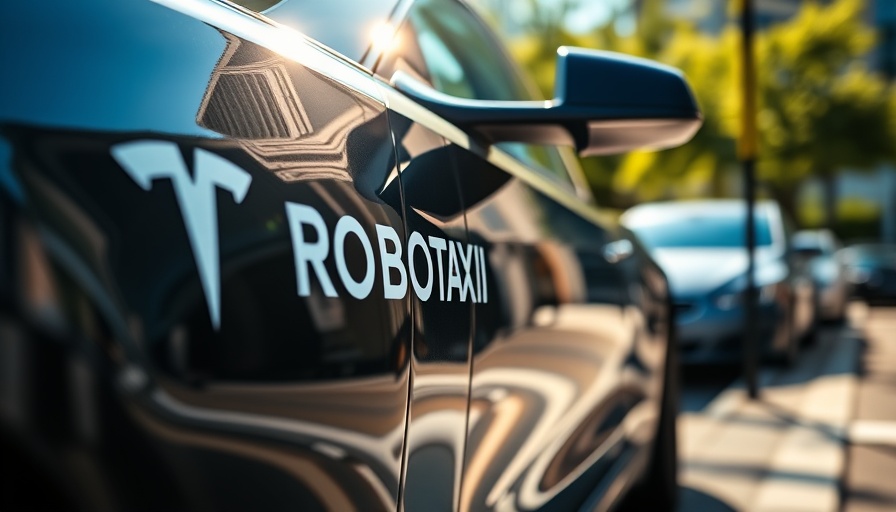
Tesla's Robotaxis: A Game Changer in Transportation
Tesla, famed for pushing the boundaries in electric vehicles, has ventured into uncharted territory with their autonomous robotaxis. Recently, the launch of these robotaxis in Austin has sparked interest not only from passengers but also from the nation’s safety regulators.
Regulatory Oversight and Safety Concerns
Federal safety regulators have promptly reached out to Tesla after observing multiple infractions captured in videos posted online. The National Highway Traffic Safety Administration (NHTSA) took swift action following reports of robotaxis flouting traffic rules in South Austin. According to NHTSA, which is supposed to uphold vehicle safety standards, they have begun communicating with Tesla to investigate these developments further.
As an important body enforcing the Vehicle Safety Act, NHTSA has confirmed they will rigorously scrutinize any potential risks associated with Tesla's latest technology. They noted, "NHTSA does not pre-approve new technologies or vehicle systems...rather, manufacturers certify that each vehicle meets NHTSA’s rigorous safety standards." This underlines the dual responsibility resting on the shoulders of manufacturers and regulators as technology rapidly evolves.
Understanding the Technology Behind Tesla's Robotaxis
To comprehend the whirlwind of attention around these autonomous rides, it’s essential to understand what makes them unique. Tesla’s robotaxis utilize an unsupervised version of their Full Self-Driving (FSD) software, which differs from the version available to typical vehicle owners — the latter requiring human oversight with hands on the wheel.
The exciting component of this launch is the ability for passengers to hail these self-driving vehicles through an app, signifying an innovative approach to mobility. However, the presence of a human safety monitor is a significant acknowledgment of the potential uncertainties regarding fully autonomous driving.
Public Reaction and Future Implications
Public sentiment on this new technology has been a mix of enthusiasm and caution. Videos depicting the robotaxis speeding and erratically changing lanes have garnered significant viewer attention, raising eyebrows among safety advocates. Some observers, including Ed Niedermeyer, an author monitoring the launch, have documented incidents where robotaxis exhibited abrupt braking behaviors in the presence of police vehicles, further fueling discussions on safety protocols.
A World of Possibilities: The Future of Autonomous Vehicles
As Tesla's robotaxis hit the streets, they represent a broader trend that is reshaping transportation. Autonomous vehicles hold the potential to reduce accidents caused by human error, improving overall road safety. However, the road ahead is fraught with substantial challenges, not the least of which is gaining public trust and navigating regulatory landscapes.
Experts believe that as this technology matures, we will see better integration of artificial intelligence in navigating complex driving scenarios. Future iterations of robotaxis may incorporate advanced telematics to enhance decision-making and situational awareness.
Industry Responses and the Ongoing Debate
The introduction of Tesla’s robotaxis has ignited heated discussions across the tech community and the automotive sector. Some industry leaders advocate for a cautious approach, prioritizing comprehensive testing and validation before any broad rollout. In contrast, proponents of immediate integration emphasize the potential benefits of providing a seamless, autonomous transport option to the public.
As the debate continues, stakeholders from various sectors must converse to align on safety standards and regulations that can accommodate both innovation and consumer safety.
The Wider Context of Autonomous Technology in Society
The conversation surrounding Tesla's robotaxis cannot be divorced from the global context surrounding autonomous vehicles. Countries like Germany and China are also investing heavily in AI-driven transportation systems, making the international competitive landscape even more critical.
Understanding the trajectories of different nations in adopting such technologies may offer valuable insights into regulatory practices and consumer acceptance worldwide. A balanced understanding will be essential for industry players aiming to mitigate risks and promote safe technological advances.
Concluding Thoughts: Driving into the Future
The commencement of Tesla's robotaxi service acts as a litmus test for the future of autonomous vehicles on our roads. While the potential advantages offer exciting prospects, the overarching priority must remain centered on safety and reliability. As we navigate these transformative times, it will be crucial for companies, regulators, and consumers to coalesce around common goals — to enhance mobility without compromising safety.
In light of the ongoing developments, we encourage readers to keep informed and stay engaged with the latest tech news as this story unfolds. The evolution of transportation is not merely a tech story but a shared venture that affects every one of us.
 Add Row
Add Row  Add
Add 



Write A Comment